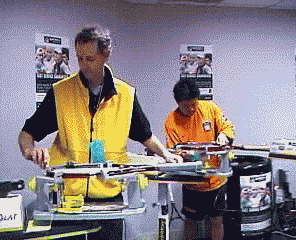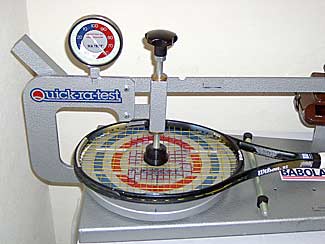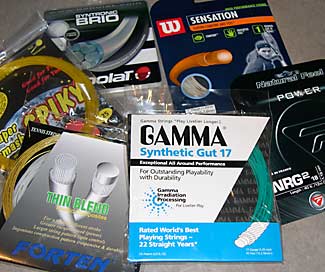|
TennisOne Lessons
The Truth About Strings and Things By Roger Gough
Tension. We all have it. You have tension in your work, home and in your social life. Sometimes the tension builds up when the pressures of life are just too much.So what do you do? You hit the tennis court. Knock a few balls around, hit some big serves and angry forehands and let it all out. As a racquet stringer, my tension is your racquet's string tension. In many ways the tensions of life are much greater understood than your racquet's string tension. Why? Well, I don't think string tension is the most crucial item to many tennis players. However, your racquets string tension should be a priority. Just like choosing the correct racquet for your style of play, a racquet string should give you the performance you are looking for. String Tension First, it's important to understand what is meant by string tension. When you look at the inside throat of your racquet you will find the manufactures string tension recommendation. This string tension range might say something like 22 - 27 KG (50 - 60 LBS) like on my Wilson Tour 90. The two series of numbers given here are both referred to as "reference" tensions. This is the number you give to your racquet stringer, which he/she will in turn set his/her stringing machine dial at. Which number you refer to generally depends on which system you are used to using. Second, in the tennis sense, tension refers to the stretch or elongation of the racquet string when "tensioned" by a racquet stringing machine. What is interesting is how the "reference" tension (the number you give your racquet stringer) and a strings "elongation" tendency affect each other.
A racquet string, like a rubber band, will elongate or stretch more as the pulling force is increased. So, the higher the "reference" tension the more the racquet string will elongate. As a racquet string is elongated more and more, the tighter and stiffer your string bed of your racquet will become. This is known as "dynamic stiffness." String Composition With this knowledge, you can now consider how the "reference" tension you consider might affect the string you choose to put in your racquet. The first feature of a racquet string to consider when selecting a "reference" tension is string construction. When evaluating racquet string construction you must consider the material used to construct the string and the actual construction of the string itself. A racquet string's material and construction are what gives each individual string its unique properties and feel. The material most used in racquet string is nylon. Nylon provides the best combination of the three S's for racquet string: strength, stretch, and stiffness. As a result, nylon is used to create strings that have the combined best benefits for control, power, comfort, and durability. There are materials other than nylon used in racquet strings that have unique properties and benefits. For example, kevlar has much more strength than nylon, and therefore is very durable. Polyester, a material that has seen recent growth in use, has similar properties to nylon. The main difference between polyester and nylon is that polyester is about three times stiffer than nylon. This gives polyester a less comfortable feel than nylon. Polyester, however, is more resistant to abrasion, which does make it more durable than nylon. Because polyester, a monofilament string, is resistant to bonding, it is limited to construction variations unlike nylon. Although, Gosen America , has recently introduced a tri-filament polyester string called "Comfort."
String material will affect the feel of your racquet and therefore you must adjust the "reference tension" prior to re-stringing. Since almost all string materials have a greater "dynamic stiffness" than nylon; you will want to lower your "reference" tension. For a very stiff string like Kevlar you will lower your "reference" tension by about 5 to 8 pounds. For polyester, which is less stiff than Kevlar, you will lower the "reference" tension by 2 to 4 pounds. String Construction Racquet string has an infinite number of constructions available today. There are solid core strings with single wraps or multi-wraps; multicore strings with single and multi-wraps, multi-filaments, composites, textured, and monofilament. "A string is the sum of its parts." There are two main guidelines to follow when considering the strings construction. First, the material composed in the string will dictate that strings playability more than its construction. Second, the thickest fiber, generally the core of the string, will over shadow the thinner fibers of the string. When considering your "reference" tension, first find out what material the string is made of. Second, look at the string's filament or fiber makeup. Larger filaments will indicate the string will be firmer with less elasticity. This type of construction is the traditional nylon "synthetic gut" strings. Because of the larger solid core, this type of string construction will maintain its tension better than a string composed of thinner filaments. The benefit of string construction with many thin filaments is the elasticity will be greater and the string will have a softer or more comfortable feel. A soft string will have a lower "dynamic stiffness." In this case you may want to consider adding 2 to 4 pounds to your normal "reference" tension.
Another major feature of a racquet string to consider when selecting a "reference" tension is string diameter or "gauge." Most racquet strings are produced in different gauges. Common string thickness is 15 (thick), 16, 17, and 18 (thin) gauge with variations in between depending on manufactures. Let's look at a thicker string compared to a thinner string and how your choice will affect the tension you consider. A thinner string is thought to be softer. However, when you string the same model racquet with a thicker string and one with a thinner string at the same "reference" tension, the racquet with the thinner string will have a greater "dynamic stiffness" (firmer feel) than the racquet strung with the thicker string. Therefore, when choosing between similar string but in different gauges, you will want to decrease the "reference" tension of the thinner string to achieve a lower "dynamic stiffness" in the string bed compared to a thicker string. The exact amount to decrease will vary, but consider subtracting 2 to 4 pounds from your normal "reference" tension. With all the tension in your life, choosing a racquet string tension for your restring won't be the most stressful part of your day. However, with this information in hand, you should be well on way to matching the appropriate "reference" tension with a terrific racquet string of your choice. Your comments are welcome. Let us know what you think about Roger Gough's article by emailing us here at TennisOne. |



